Different Types Of Ducks
If you are considering raising ducks, you may be overwhelmed by the number of options available. There are several different breeds of domestic ducks, all with their own distinct attributes and advantages. While you may not know where to start, know that among the list of choices, there is a breed for everyone.
What are 15 different types of ducks? Fifteen duck breeds that we would recommend for the homestead are:
- Pekin
- Khaki Campbell
- Indian Runner
- Muscovy
- Cayuga
- Mallard
- Call
- Aylesbury
- Crested
- Welsh Harlequin
- Silver Appleyard
- Buff Orpington
- Magpie
- Saxony
- Rouen
Which breed you choose will depend on the purpose you want to raise ducks and in which type of environment they will be raised. To learn more about what makes each of these breeds unique read on for more detailed information. We are confident you will find one (or two or three) breeds that are perfect for what you’re looking for.
Duck Breeds
Pekin Duck 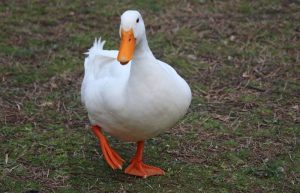
Looking for the classic white farm duck with which most of us are familiar? If so, you should look into the Pekin. Pekins are an excellent choice for both egg-laying and for meat production, as they are known as a “dual-purpose” breed.
They are large, heavy birds with white feathers and orange feet and bills. Pekins are by far the most commonly kept ducks on the homestead, and in fact, 90% of the duck meat produced in North America comes from the Pekin breed. As a bonus, they are generally friendly and curious, making them a joy to raise.
Khaki Campbell Duck 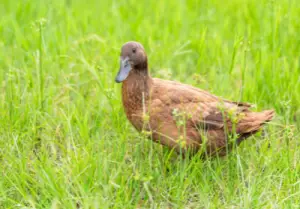
While most of the ducks on this list are prolific layers, it would be a challenge to find a duck breed that lays more eggs than the Khaki Campbell. Campbells are known to lay as many as 300 eggs per year.
Khaki Campbells are a medium-weight breed but are still considered dual-purpose, with the ability to be used for meat production as well. Khaki Campbells get their name from the solid light brown coloring of the females.
Indian Runner Duck 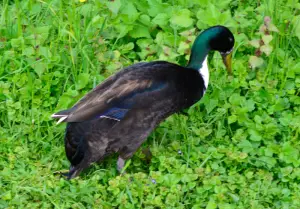
If you have ever seen an Indian Runner, you will understand why they are sometimes called bowling pins on legs. Indian Runners are unique in conformation as they stand upright like penguins and have long, lean bodies.
Runners are exceptional layers, producing an average of 4-5 blue-tinted eggs per week. Their egg production is the reason they were used in the creation of the Khaki Campbell; however, they are too light to be considered a true dual-purpose breed.
Muscovy Duck 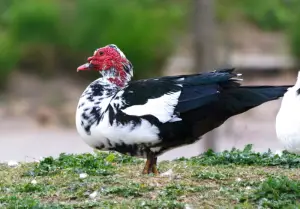
If you have close neighbors and are looking for a quieter breed, the Muscovy may be a good choice. Muscovy’s are not actually the same species as the rest of the ducks on this list (who are mostly derived from the Mallard), and they do not quack like the typical female duck – instead, the female Muscovy has a quiet coo.
In addition to their quiet nature, they have a unique appearance, with the drakes boasting a red fleshy growth on their faces. While the Muscovy makes an excellent backyard friend, they are not as prolific as other laying breeds on this list.
Cayuga Duck 
Are you looking for eggs that will add color to your kitchen counter? Cayugas are black – black feathers, black bills, black feet – and their early-season eggs are charcoal or black as well. Why do we specify “early-season”?
As each season stretches along, their eggs actually fade, with late-season eggs having a very light-gray shell. Their own appearance mirrors that of their seasonal eggs, with the beautiful black birds fading to speckled and finally white as they age.
Mallard Duck 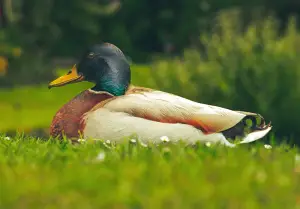
The Mallard duck is thought to be the ancestor of all domestic duck breeds (other than the Muscovy). While they are not the most productive layers – usually laying only a couple of eggs per week during the peak of the season – they are beautiful and fun to have around if you would like a true heritage breed.
If you would like to try your hand at raising this breed, make sure to get them from a reputable hatchery. It is illegal to remove Mallards from their natural habitat, and many responsible breeding programs “mark” their Mallards by removing the back toe as soon as they are hatched to show that they have been bred instead of removed from the wild.
Call Duck 
Though they are not a good choice for eggs or for meat production, Call ducks are a popular choice for raising as pets or for 4H and FFA. Call ducks have a friendly temperament and are of diminutive size, with adults reaching less than 1.5 pounds at maturity.
They were originally bred by hunters to attract ducks with their loud call, but have been replaced in the industry with the invention of duck decoys. Because they were bred to have a loud call, they are quite noisy and may not be the best choice if you have close neighbors.
Aylesbury Duck 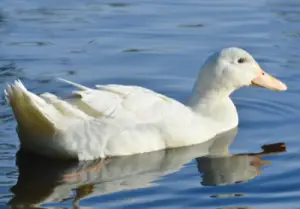
The Aylesbury duck is most commonly raised for its flavorful meat, preferred in England over the US-favored Pekin. Aylesbury ducks reach an impressive mature weight of 9-10 pounds at just 2-3 months of age.
While they are an excellent choice if looking for a meat bird, they are not the most prolific of layers. The Aylesbury lays an average of 35-125 eggs per year. This is a wide range, however, with some breeders consistently producing birds that lay on the higher end of that range.
Crested Duck 
The Crested duck is another good choice to raise as a pet or for exhibition because of its unique appearance and calm disposition. They are also moderately good layers, producing 2-4 eggs per week during the laying season. Crested ducks are white in color with fluffy “crests” at the tops of their heads.
While the crest gives the duck a special appearance, it is actually the result of a genetic skull deformity. The only way to successfully breed a Crested duckling is to breed a Crested with a non-crested duck, with ¼ of the eggs failing to hatch, ¼ of the eggs resulting in crest-less ducklings, and ½ of the eggs producing crested ducklings.
Welsh Harlequin Duck 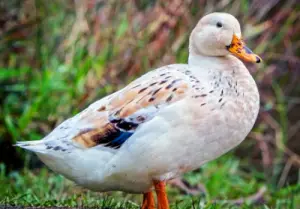
Welsh Harlequins are great layers, a good choice for meat production, and have a friendly and calm disposition. They are also a good option if you are looking to hatch a brood of ducklings on your homestead – unlike many domestic waterfowl, Welsh Harlequin have a tendency to go broody and sit on a clutch of eggs.
If you are looking specifically for female ducks (or specifically for drakes, for that matter), Welsh Harlequins can be easily sexed by the color of their bills just a few days after hatching.
Silver Appleyard Duck 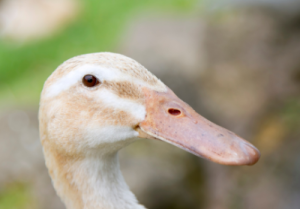
Another good dual-purpose breed, Silver Appleyards lay 220-265 eggs per year on average and are large and heavy at maturity. Though subjective, Silver Appleyards are considered to have the best-tasting meat among duck breeds, known for being lean and flavorful. To top it off, the breed has a calm temperament and tends to stay close even when allowed to free-range.
Buff Orpington Duck 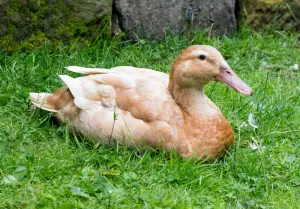
The same person who created the Buff Orpington chicken also gave us the Buff Orpington duck. Like its landfowl namesake, it has beautiful fawn (buff) coloring and a sweet, gentle disposition.
Females of this breed have a striking brown bill, while drakes have a more traditional yellow bill. They are moderately good layers and of medium size, reaching a processing weight by 8-10 weeks of age.
Magpie Duck 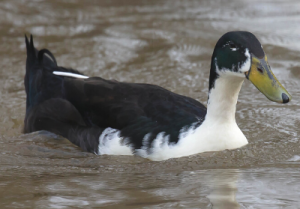
Magpies are lightweight and great layers, averaging 4-5 eggs per week. They are most often found in white with black spots, and they can produce white, cream, blue, or green eggs.
Generally considered to be quiet birds, they are an excellent choice if you have close neighbors but would like a variety of colored eggs.
Saxony Duck 
If you like the fawn coloring of the Buff Orpington but would like a heavier meat bird, the Saxony might be a good choice.
Saxony ducks are an excellent dual-purpose breed, producing a large number of eggs per season and growing quickly to a mature weight. As a bonus, these ducks are generally calm and curious by nature.
Rouen Duck 
If you love the coloring of the Mallard but would like a more productive duck, the Rouen is a good choice. Nearly identical in appearance to the Mallard, they are heavy enough to prohibit flying, large enough to use as meat if desired, and known to lay 3-5 eggs per week.
They are calm and friendly, making them easy and fun to keep.
Which Duck Breed Is Right For You?
Ducks are excellent multi-purpose animals to keep on the homestead. They are generally friendly when compared to other domestic poultry, produce large, flavorful eggs, and can be used for meat production. Whatever the reason that you are looking into ducks, you will surely find a good fit for your situation within this list of popular homestead breeds. You can learn more about ducks and other animals in my latest articles here!
